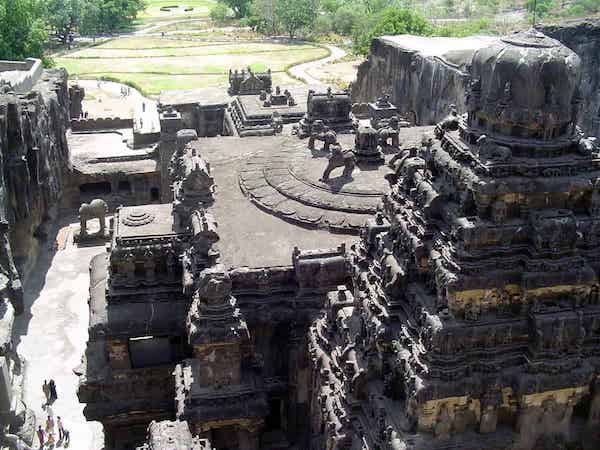The Kailasa Temple
The Kailasa Temple is one of India’s greatest monuments that has been carved from a single rock. The Kailasa Temple is a particularly notable cave temple in India as a result of its size, architecture, and having been entirely carved out of a single rock. It is situated in the Ellora, a UNESCO World Heritage site located in the Aurangabad district of Maharashtra, India. Ellora is one of the largest rock-cut monastery-temple cave complexes in the world, featuring Hindu, Buddhist, and Jain monuments, and artwork, dating from the 600–1000 CE period. There are over 100 caves at the site, all excavated from the basalt cliffs in the Charanandri Hills, 34 of which are open to the public. These consist of 12 Buddhist (caves 1–12), 17 Hindu (caves 13–29), and 5 Jain (caves 30–34) caves, each group representing deities and mythologies prevalent in the 1st millennium CE, as well as monasteries of each respective religion.

The Kailasa temple, inspired by Mount Kailasa, is dedicated to Shiva. It is modeled along similar lines to other Hindu temples with a gateway, an assembly hall, a multi-story main temple surrounded by numerous shrines laid out according to the square principle, an integrated space for circumambulation, a garbha-grihya (sanctum sanctorum) wherein resides the linga-yoni, and a spire-shaped like Mount Kailash – all carved from one rock. Other shrines carved from the same rock are dedicated to Ganga, Yamuna, Saraswati, the ten avatars of Vishnu, Vedic gods and goddesses including Indra, Agni, Vayu, Surya, and Usha, as well as non-Vedic deities like Ganesha, Ardhanarishvara (half Shiva, half Parvati), Harihara (half Shiva, half Vishnu), Annapurna, Durga, and others. The basement level of the temple features numerous Shaiva, Vaishnava, and Shakti work; a notable set of carvings includes the twelve episodes from the childhood of Krishna, an important element of Vaishnavism.

The structure is a freestanding, multi-level temple complex covering an area twice the size of the Parthenon in Athens. It is estimated that the artists removed three million cubic feet of stone, weighing approximately 200,000 tonnes, to excavate the temple.
With inputs from various online sources




GIPHY App Key not set. Please check settings